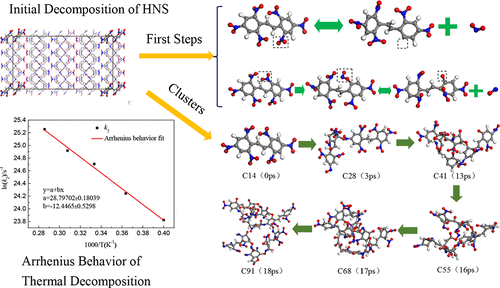当前位置:
X-MOL 学术
›
J. Phys. Chem. C
›
论文详情
Our official English website, www.x-mol.net, welcomes your
feedback! (Note: you will need to create a separate account there.)
Thermal Decomposition Mechanism of 2,2′,4,4′,6,6′-Hexanitrostilbene by ReaxFF Reactive Molecular Dynamics Simulations
The Journal of Physical Chemistry C ( IF 3.3 ) Pub Date : 2018-08-20 , DOI: 10.1021/acs.jpcc.8b03463 Lang Chen 1 , Heqi Wang 1 , Fuping Wang 1 , Deshen Geng 1 , Junying Wu 1 , Jianying Lu 1
The Journal of Physical Chemistry C ( IF 3.3 ) Pub Date : 2018-08-20 , DOI: 10.1021/acs.jpcc.8b03463 Lang Chen 1 , Heqi Wang 1 , Fuping Wang 1 , Deshen Geng 1 , Junying Wu 1 , Jianying Lu 1
Affiliation

|
2,2′,4,4′,6,6′-Hexanitrostilbene (HNS) is an explosive with increased heat resistance, and its mechanism of thermal decomposition is of interest. In this paper, the decomposition processes of HNS at various temperatures (2500, 2750, 3000, 3250, and 3500 K) are calculated by large-scale reactive molecular dynamics simulations. The initial reactions and the evolution of clusters (whose molecular weight is larger than HNS) are analyzed. The reaction kinetics parameters are fitted. The results show that the main initial decomposition mechanisms of HNS are C–NO2 bond dissociation and nitro-nitrite (NO2–ONO) isomerization. During decomposition, O atoms are less likely to be released from the cluster than H and N atoms. Low temperatures tend to produce larger clusters, and clusters at higher temperatures tend to decompose. The thermal decomposition of HNS is a combination of single-molecule and bimolecular decomposition mechanisms. The dimerization reaction is clearly weakened, and the C–N bond cleavage is still the main initial reaction path with increase in temperature. Temperature has a great influence on the structure of the clusters. Single-step kinetics is a good approximation for the thermal decomposition of HNS.
中文翻译:

通过ReaxFF反应分子动力学模拟研究2,2',4,4',6,6'-六硝基二苯乙烯的热分解机理
2,2',4,4',6,6'-六硝基二苯乙烯(HNS)是一种具有增强的耐热性的炸药,其热分解机理令人关注。本文通过大规模的反应分子动力学模拟计算了HNS在不同温度(2500、2750、3000、3250和3500 K)下的分解过程。分析了初始反应和簇的演化(分子量大于HNS)。拟合反应动力学参数。结果表明,HNS的主要初始分解机理是C–NO 2键解离和亚硝酸根(NO 2-ONO)异构化。在分解过程中,与H和N原子相比,O原子从团簇中释放的可能性较小。低温倾向于产生较大的团簇,而在较高温度下的团簇倾向于分解。HNS的热分解是单分子和双分子分解机制的组合。随着温度的升高,二聚反应明显减弱,并且C–N键的裂解仍然是主要的初始反应路径。温度对簇的结构有很大的影响。单步动力学是HNS热分解的一个很好的近似值。
更新日期:2018-08-20
中文翻译:

通过ReaxFF反应分子动力学模拟研究2,2',4,4',6,6'-六硝基二苯乙烯的热分解机理
2,2',4,4',6,6'-六硝基二苯乙烯(HNS)是一种具有增强的耐热性的炸药,其热分解机理令人关注。本文通过大规模的反应分子动力学模拟计算了HNS在不同温度(2500、2750、3000、3250和3500 K)下的分解过程。分析了初始反应和簇的演化(分子量大于HNS)。拟合反应动力学参数。结果表明,HNS的主要初始分解机理是C–NO 2键解离和亚硝酸根(NO 2-ONO)异构化。在分解过程中,与H和N原子相比,O原子从团簇中释放的可能性较小。低温倾向于产生较大的团簇,而在较高温度下的团簇倾向于分解。HNS的热分解是单分子和双分子分解机制的组合。随着温度的升高,二聚反应明显减弱,并且C–N键的裂解仍然是主要的初始反应路径。温度对簇的结构有很大的影响。单步动力学是HNS热分解的一个很好的近似值。































 京公网安备 11010802027423号
京公网安备 11010802027423号